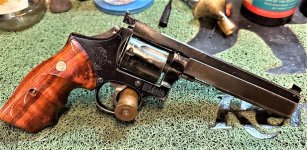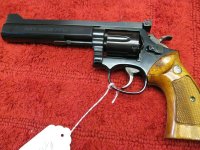I appreciate everyone's input and would appreciate even more if anyone had any other input.
If it were mine -- I would stick to lead bullets only, simply because that's what the barrel was designed around specifically. I'm sure that opinions would vary
WIDELY and I wouldn't mind hearing them, but in my opinion, this is not a high volume produced factory gun and it's purpose-built barrel is arguably irreplaceable, and it was designed specifically for 148 grain wadcutters.
I'm not saying that jacketed or plated bullets will HARM this barrel, I'm simply saying that it's outside the scope of its design. For me, I have a dozen other revolvers that eat jacketed and plated bullets, so my PPC guns shoot lead bullets only.
I would also point out that a PPC revolver barrel almost surely has some trace lead in it already and pounding jacketed or plated bullets over trace lead is definitely not a good idea at all. The bore gets incrementally smaller with lead buildup and jacketed bullets over trace lead make that lead extremely hard to remove.
The barrel is marked 148 wadcutter only. Not that it would matter, given my skill level, but I reload using 357 cases rather than 38 Special.
I don't see anything wrong with choosing to use .357 brass here, but at the same time, I would slot this right next to cleaning primer pockets. Some people do it, never will I ever do it, and if we (somehow?) had the data and evidence from thousands of PPC competitors from the 1960's through the 1980's and especially the champion shooters, I bet we wouldn't find any using .357 brass.
However, much like cleaning primer pockets, I absolutely endorse the choices that other handloaders make if the end result is their having confidence in what they are doing., and confidence in the ammo they are making. That confidence leads to success, in my opinion.
I will note, simply because it seems relevant, that the few PPC builders who elected to do builds on .357 chambered guns typically stated quite clearly to
NEVER run .357 Magnum ammo through these custom guns. The explanation I've read is that they warned against torquing of the massive barrel in the frame. This custom barrel was designed for 700-800 fps, not the 1,200-1,600 fps that you can attain with .357 Magnum.
(not that you ever suggested you were doing that with your .357 brass)




